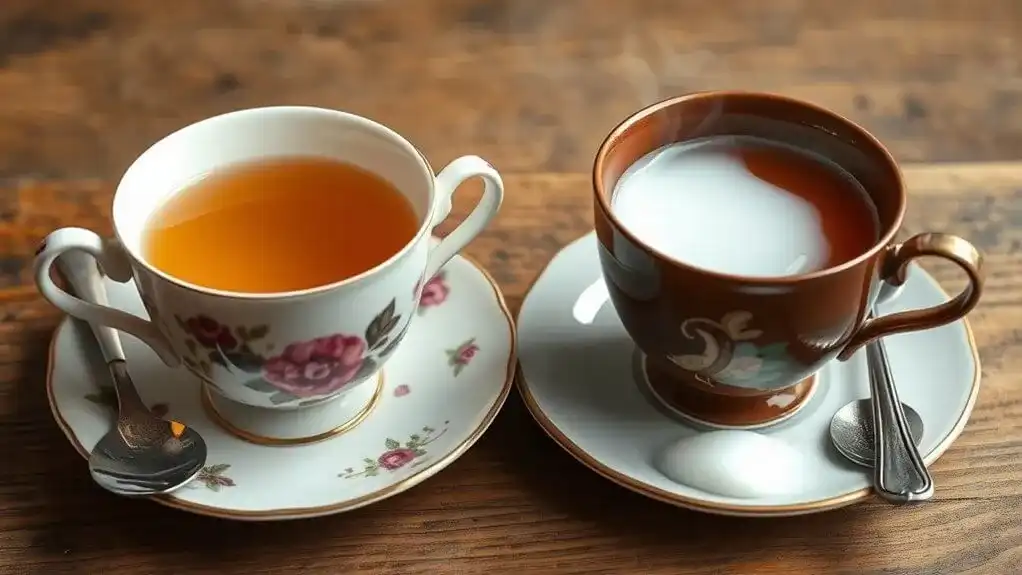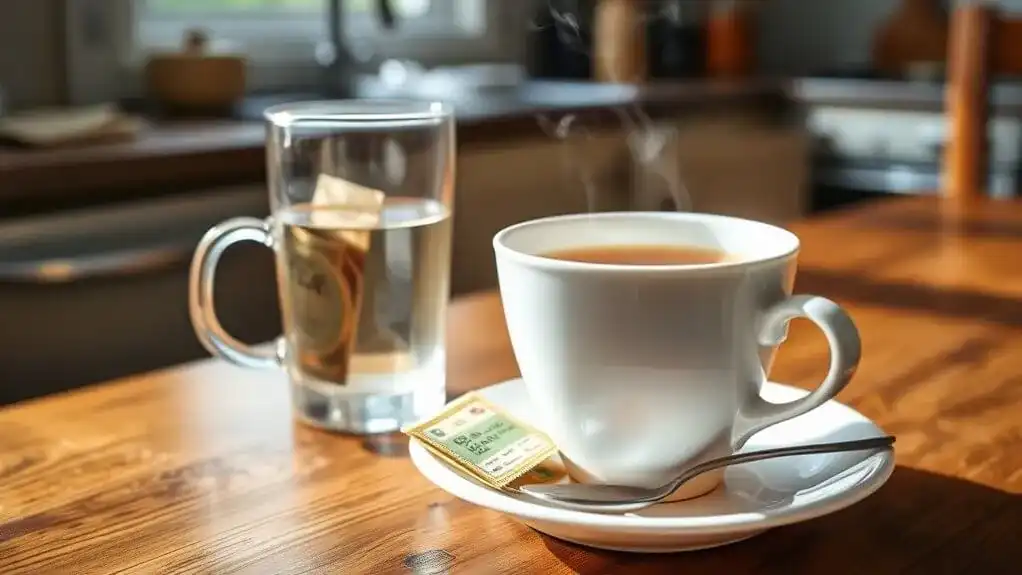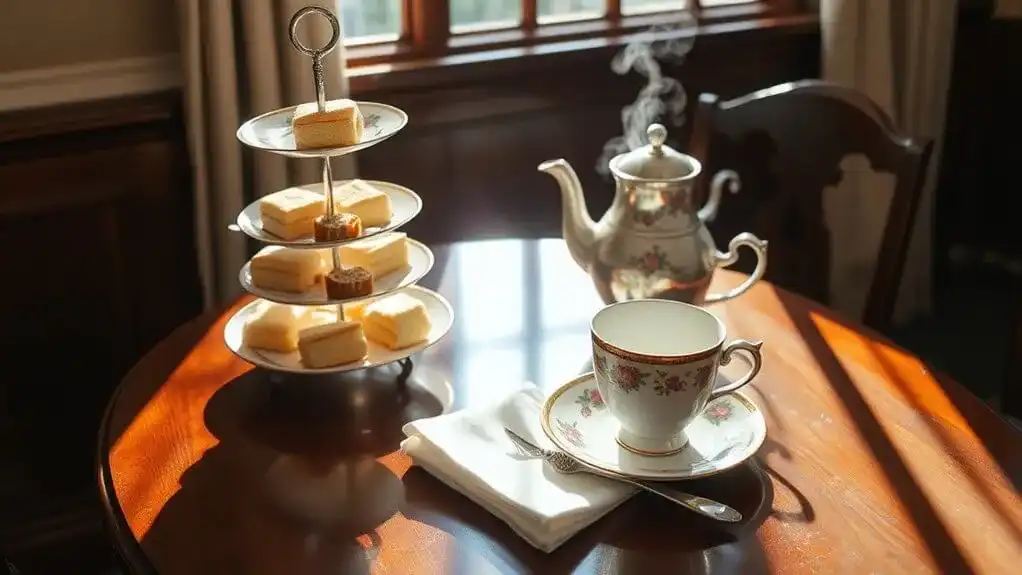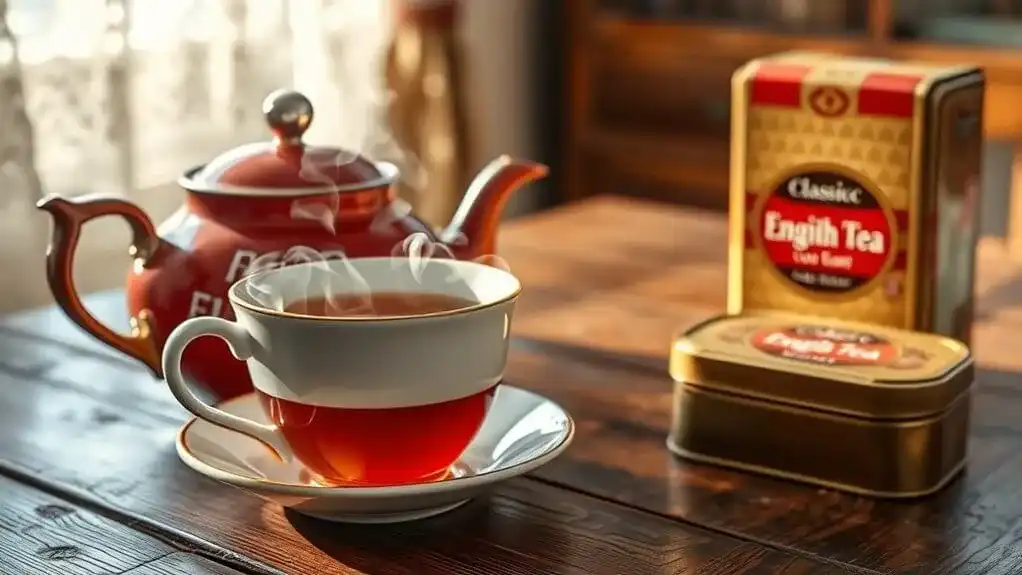Yorkshire and Lancashire's tea customs showcase distinct regional identities within Northern England's rich tea culture. Yorkshire's traditions stem from Charles Taylor's 1886 company and their signature blend tailored to local water, while Lancashire's customs remain less documented but equally cherished. Both regions embrace afternoon tea rituals, though they differ in brewing methods and dialect terms. Their historic rivalry has created a fascinating tapestry of traditions that continues to shape Britain's tea-drinking landscape.
Key Points
- Yorkshire Tea was specifically created in the 1970s to complement the region's water supply, while Lancashire lacks a distinctive regional tea brand.
- Yorkshire residents consume 2.6 daily tea cups, focusing on proper brewing methods with milk added after steeping.
- Both regions feature afternoon tea traditions, with Yorkshire favoring tea loaf and Wensleydale cheese, while Lancashire specializes in Eccles cakes.
- Yorkshire's tea vocabulary shows Viking influences, while Lancashire's tea-related dialect reflects its industrial heritage.
- High tea customs differ slightly, with Yorkshire traditionally serving between 5-6 PM and emphasizing family prosperity through local delicacies.
Historical Tea Traditions: Yorkshire and Lancashire Through Time
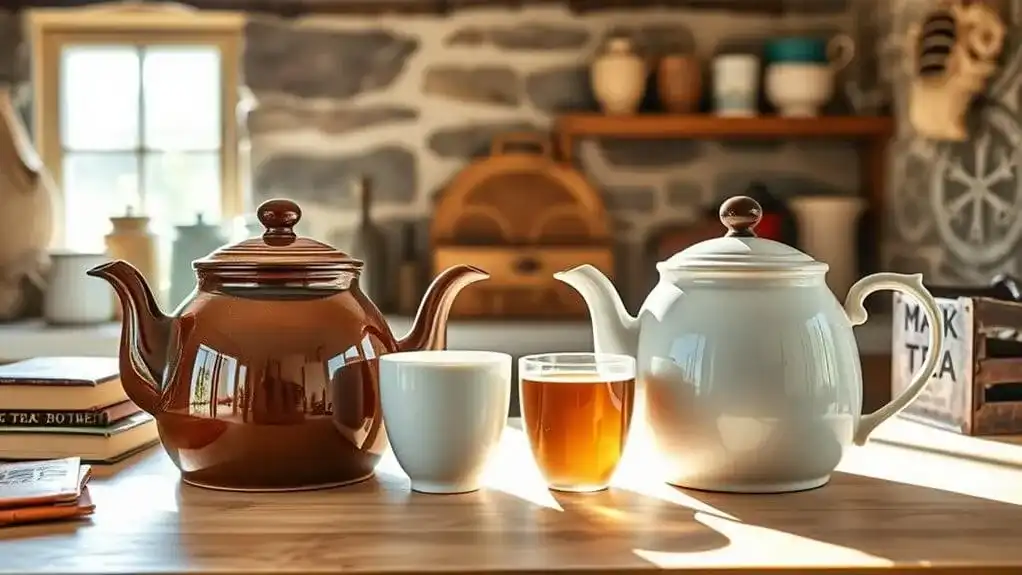
While both Yorkshire and Lancashire share a rich heritage of tea drinking, Yorkshire's customs are particularly more documented and commercially significant. The region's tea heritage gained prominence when Charles Taylor established his tea company in 1886, leading to the creation of various infusion varieties that catered to local tastes. Yorkshire Tea, crafted specifically for the region's water supply in the 1970s, stands as a representation of this tradition. The company sources its teas from over twenty locations across Africa and India. The company's dedication to quality earned them a gold medal at the London Grocery Exhibition in 1896.
High teas in Yorkshire, served between 5 and 6 pm, featured local delicacies like homemade bread, pickles, and ham from locally kept pigs. Sunday afternoons were especially significant as families would showcase their prosperity and culinary skills. While Lancashire likely had similar customs, historical records aren't as detailed. Both regions valued tea as a symbol of community, particularly during funeral teas, though Yorkshire's practices are better preserved in historical documentation.
Tea Drinking Statistics: A Tale of Two Counties
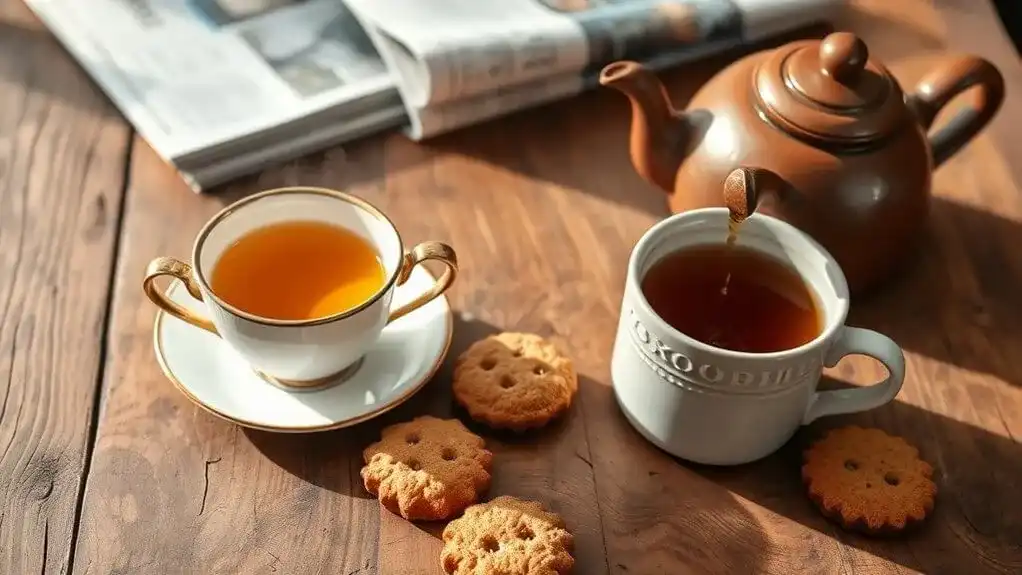
Modern tea consumption data offers surprising insights into Yorkshire and Lancashire's drinking habits. Despite Yorkshire's strong tea heritage and famous brand, the region actually consumes fewer cuppas than the national average, with residents drinking 2.6 cups daily compared to the UK's three-cup average. Historical evidence shows that first British tea was consumed in Yorkshire back in 1644. The region's tea prominence grew significantly when Tetley relocated, leaving Yorkshire Tea as the county's primary tea producer.
While specific Lancashire tea consumption figures aren't available, the data shows interesting regional preferences across Northern England. The North-East leads the nation with 3.8 cups per day, while Scotland surpasses Yorkshire with 2.8 cups. However, Yorkshire Tea remains a market powerhouse, holding nearly 23% of the UK black tea market and ranking as the nation's most searched-for tea brand with 27,000 monthly queries. This suggests that while Yorkshire residents might drink less tea, they've successfully exported their tea culture across the country. Regional water quality plays a significant role in tea preferences, with softer northern water being particularly well-suited for brewing the perfect cup.
Regional Dialect and Tea Culture
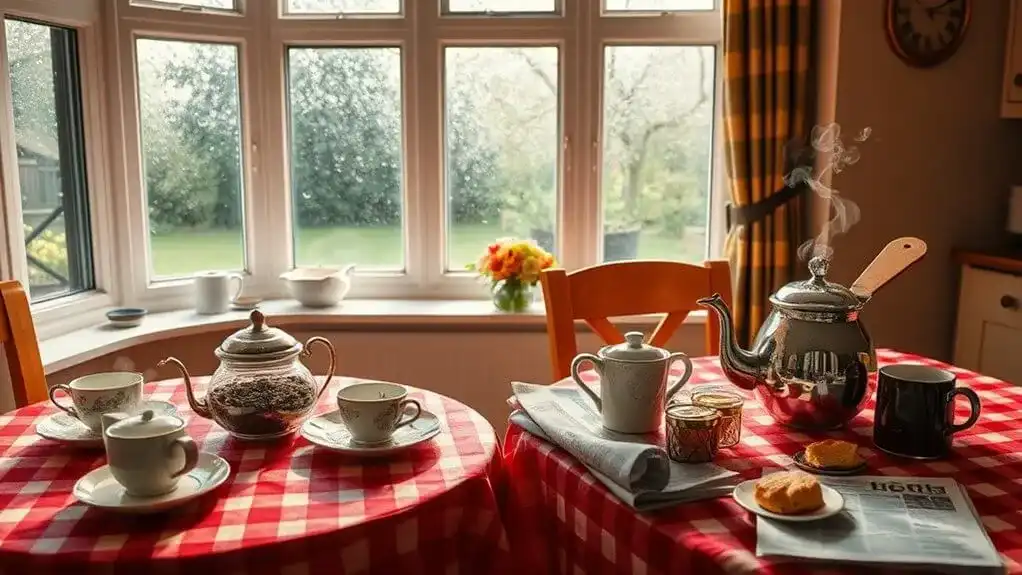
Throughout the centuries, distinct regional dialects have shaped how Yorkshire and Lancashire residents discuss their beloved tea customs. The Viking influence on Yorkshire's dialect and Lancashire's rhotic pronunciation have created unique tea terminology in each region. While Yorkshire's strong Scandinavian roots have influenced their tea-related vocabulary, Lancashire's industrial heritage has shaped clearer vowel pronunciations when discussing tea customs.
The dialect variations between these counties reflect their diverse cultural histories. Yorkshire's internal dialect differences, particularly between North and West Ridings, have led to multiple terms for tea-related activities. Following the Norman Conquest in 1066, French loanwords entered the tea-drinking vocabulary of both regions. The Humber-Lune Line historically created a sharp linguistic divide in how northern and southern Yorkshire residents described their tea customs. Despite mass media's homogenizing effect on regional dialects, remote areas in both counties maintain traditional tea-related expressions. These linguistic differences continue to influence how locals describe everything from brewing methods to tea-drinking rituals.
The Battle of Tea Brands and Brewing Methods
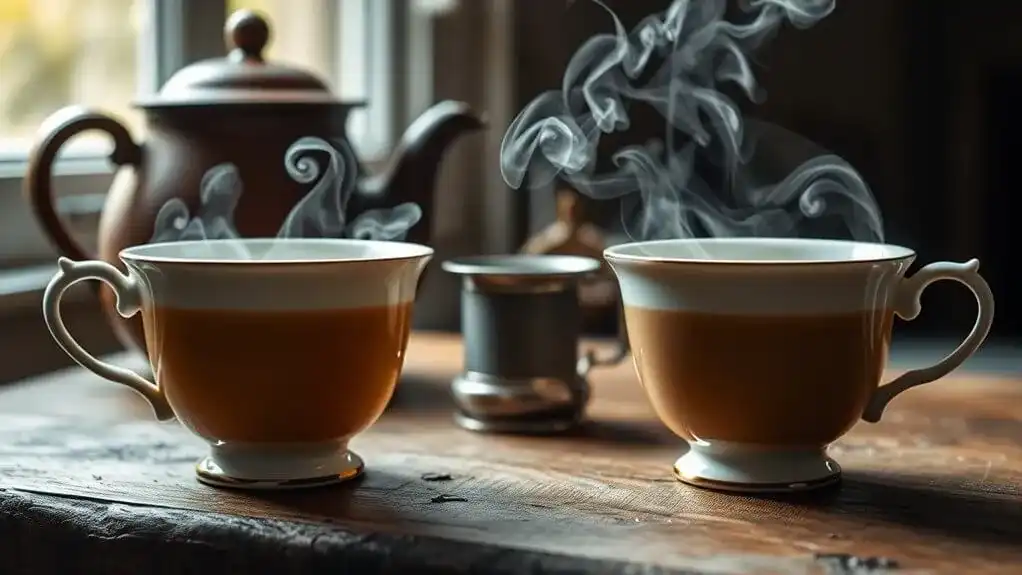
Despite their shared passion for tea, Yorkshire and Lancashire have cultivated distinct brand loyalties and brewing methodologies that reflect their competitive heritage. Yorkshire Tea, backed by Taylors of Harrogate's 130-year legacy, has established itself as a dominant force through traditional processing methods and precise brewing guidelines. In contrast, Lancashire Tea, though newer to the market, has carved out its own loyal following over the past two decades. Tetley's has emerged as the dominant brand in Lancashire regions, adding to the competitive landscape. The careful selection of only premium quality leaves ensures consistent flavor profiles for both regional brands.
Tea preferences often spark brewing controversies between the regions, particularly regarding milk timing and steeping duration. While the British Standards Institution recommends adding milk first and brewing for six minutes in a porcelain teapot, Yorkshire Tea advocates a 4-5 minute steep time and adding milk after brewing when using the mug method. These distinctions have become points of pride for both counties' residents. The company's dedication to quality is evident in their extensive product range, from their popular Yorkshire Loose Tea to premium gold varieties.
Social Gatherings and Tea Etiquette
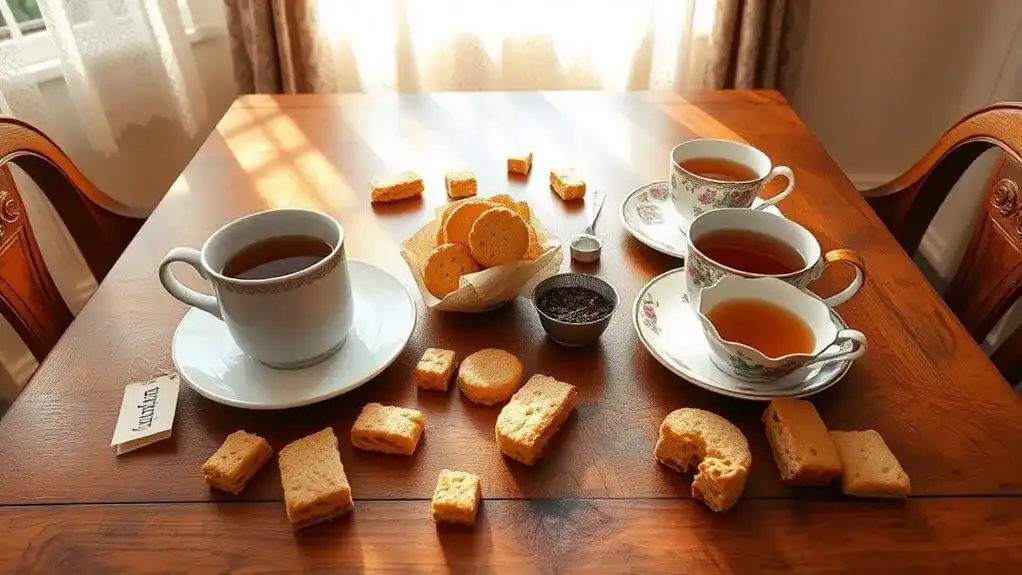
While both Yorkshire and Lancashire share certain tea etiquette fundamentals, each region's social gatherings reflect their distinct cultural interpretations of proper tea service. In both counties, the social connections formed during afternoon tea remain a cornerstone of community life, with hosts carefully orchestrating the experience from start to finish. Entertainment often includes after-dinner performances where guests enjoy music or poetry while sipping their tea. The traditional approach calls for tiered serving stands with scones placed on top, sandwiches in the middle, and sweets on the bottom tier.
The cultural significance of proper tea etiquette is evident in shared customs: guests must hold teacups by their handles, keep elbows off tables, and use napkins appropriately. Hosts are expected to lead the proceedings by placing their napkins first and serving others before themselves. When the session concludes, the hostess signals its end by picking up her napkin, with guests following suit. A proper tea service includes separate serving spoons for jam and cream to maintain cleanliness and prevent cross-contamination. Despite minor regional variations, these customs reinforce the importance of maintaining decorum during tea gatherings.
Tea Accompaniments: Cakes, Pastries, and Local Favorites
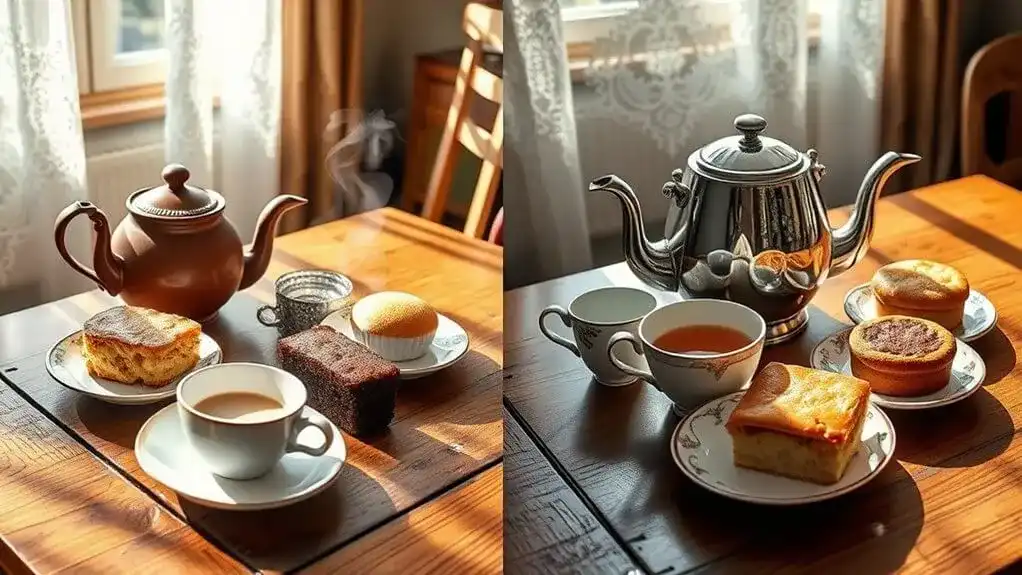
As tea traditions evolved in Yorkshire and Lancashire, distinct local delicacies emerged to complement the beloved beverage. In Yorkshire, the tea loaf stands as a signature treat, with dried fruits soaked in Yorkshire tea creating unique cake pairings with Wensleydale cheese. Lancashire offers different pastry variations, featuring Eccles cakes and the spicy warmth of Parkin, a traditional ginger cake. The popular tea loaf can be enhanced by brewing fresh tea over dried fruits and letting them soak overnight for maximum flavor. The region's most innovative establishments, like Mojo bar in Leeds, are revolutionizing how these traditional treats are enjoyed by pairing them with creative tea-infused cocktails.
Modern tea rooms across both regions now showcase:
- Tea-infused cocktails blending local spirits with traditional brews
- Yorkshire Brack and Lancashire Fat Cake served with contemporary twists
- Innovative tea and cheese pairings featuring local dairy products
- Experimental bakes incorporating regional tea blends
These regional differences highlight how each county's tea culture has developed its own identity while maintaining traditional flavors that locals cherish.
High Tea Vs Low Tea: Northern Interpretations
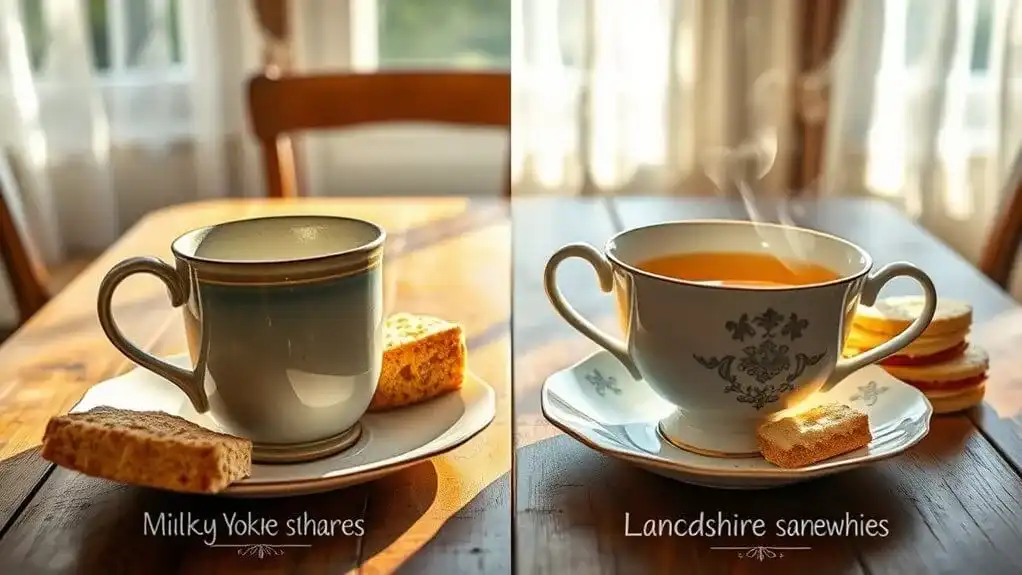
The distinction between High Tea and Low Tea in Northern England reflects deep-rooted social class traditions that continue to influence modern dining customs. High tea, traditionally served in working-class households at high dining tables in the early evening, features hearty dishes like shepherd's pie, cold cuts, and cheese. It's often synonymous with dinner in many Northern homes today. The proper serving time for this meal is at 4 or 5 pm. Modern establishments often offer 3-tier trays featuring an elegant progression of treats from savory to sweet.
In contrast, low tea emerged from aristocratic circles, served around 3-4 p.m. on low tables in formal drawing rooms. It's characterized by delicate offerings like finger sandwiches, scones with clotted cream, and petit fours. While Yorkshire and Lancashire share these basic distinctions, regional variations exist, with Scotland incorporating hot dishes into their high tea service. Modern establishments often blend elements of both traditions, though the working-class roots of high tea remain evident across the North.
The Modern Tea Experience in Northern England
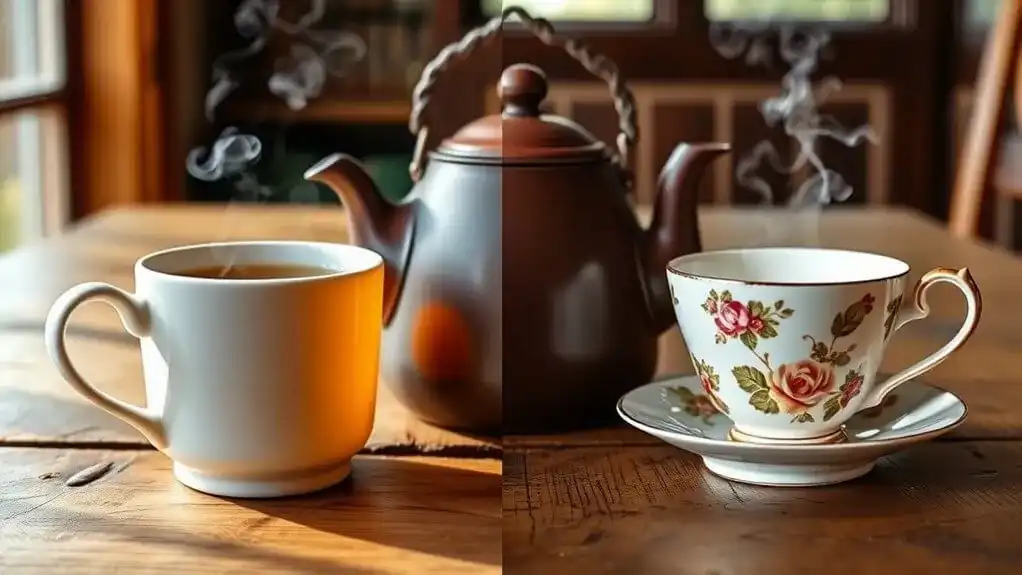
Modern tea experiences in Northern England seamlessly blend centuries-old traditions with contemporary innovations. Modern tea venues like The Grand in York and Bettys showcase this evolution, offering luxurious settings where guests can savor both classic and innovative tea experiences. The Grand particularly stands out with its Newby teas selection and cocktail options. A popular choice at afternoon venues is English Breakfast blend, which combines Assam and Ceylon teas for a robust morning cup. Many establishments like Carden Park Hotel offer their guests estate-grown wines to complement their afternoon tea experience.
The region's tea culture has expanded beyond traditional offerings to include:
- Themed afternoon teas featuring local literary connections and seasonal inspirations
- Art Deco-inspired settings that combine vintage charm with modern service
- Fusion experiences incorporating international flavors, particularly Indian influences
- Family-friendly venues with creative presentations and child-specific menus
While classic black teas remain the most popular choice, venues now offer extensive selections including green, oolong, and herbal varieties. Local ingredients take center stage in many establishments, reflecting Northern England's commitment to regional identity while embracing contemporary tastes.
Conclusion
While the friendly rivalry between Yorkshire and Lancashire isn't going anywhere, their shared passion for a proper cuppa continues to unite these proud counties. Though some may say the north-south divide runs deep, it's the humble teapot that bridges cultural gaps and soothes regional tensions. Today's tea drinking customs in northern England aren't just surviving – they're thriving, breathing new life into age-old traditions.
